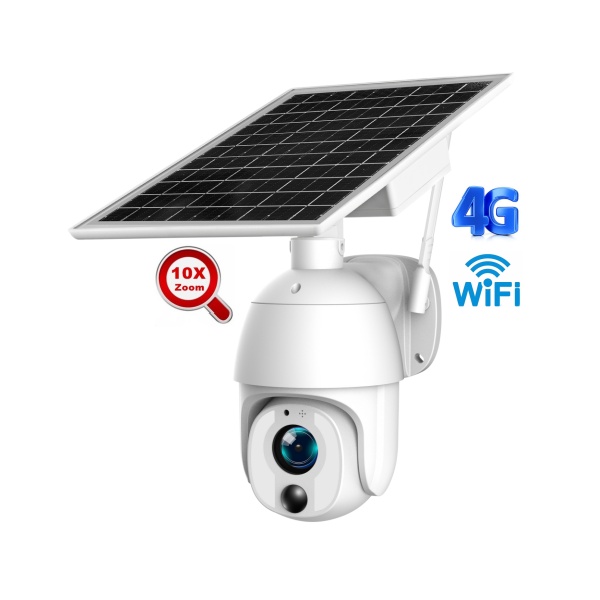Scrapyard Security: How 4G Solar Cameras Prevent Theft and Illegal Dumping
Scrapyards and recycling centers are the backbone of a circular economy, but they are also uniquely vulnerable. Sprawling outdoor lots filled with valuable metals like copper, aluminum, and steel are prime targets for thieves. Beyond theft, these facilities often become magnets for illegal dumping, creating environmental hazards and costly cleanup bills. Traditional security systems often fall short in these rugged, off-grid environments.
As an engineer who has spent over a decade designing security solutions for challenging locations, I’ve seen firsthand how conventional cameras fail. The lack of reliable power and internet connectivity across a vast yard makes wired or even Wi-Fi-based systems impractical and prohibitively expensive. This is the critical gap where modern technology, specifically 4G solar security cameras, provides a definitive solution.
Why Traditional Surveillance Fails in Recycling Facilities
The core problem for scrapyard security isn’t a lack of options; it’s a lack of suitable options. The environment itself presents a unique set of obstacles that render standard security systems ineffective and costly to implement.
-
- Power Grid Dependency: The most valuable materials are often stored in piles far from the main office or any power source. Trenching electrical cables across a busy, heavy-machinery environment is not only expensive but also a logistical nightmare and a safety risk.
–
-
- Weak or Non-Existent Wi-Fi: Metal structures, large piles of scrap, and the sheer size of the facility effectively block or weaken Wi-Fi signals. Relying on Wi-Fi for security coverage across the entire perimeter is a recipe for dead zones and lost footage.
–
-
- High Installation & Maintenance Costs: The cost of cabling, repeaters, and professional installation for a traditional system can quickly run into tens of thousands of dollars. Ongoing maintenance for exposed wiring adds to the total cost of ownership.
–
- Environmental Wear and Tear: Scrapyards are harsh environments. Dust, rain, extreme temperatures, and vibrations from heavy equipment can quickly degrade cameras that aren’t specifically built for industrial use.
The Engineering Solution: How 4G Solar Cameras Work
A 4G solar security camera is a fully self-sufficient surveillance unit. It integrates four key technologies into a single, rugged device: a high-resolution camera, a solar panel, a high-capacity rechargeable battery, and a 4G LTE cellular modem. This combination directly overcomes the challenges faced by scrapyards.
The solar panel continuously charges the internal battery during daylight hours. A sophisticated Battery Management System (BMS) is crucial here; it optimizes charging, protects the battery from over-discharging, and ensures the camera has enough power to operate through several cloudy or rainy days. The 4G modem provides a stable, independent internet connection, allowing you to stream live video and receive alerts anywhere, without relying on local Wi-Fi.
Comparative Analysis: Finding the Right Security Fit
For business owners, wholesalers, or installers, understanding the clear advantages is key to making the right investment. A direct comparison highlights why 4G solar solutions are superior for scrapyard environments.
| Feature | Traditional Wired System | Wi-Fi Based System | UBOXCAM 4G Solar System |
|---|---|---|---|
| Power Source | Grid power required (high cost) | Grid power required (some battery options) | 100% Solar Powered (No external power) |
| Network Connection | Wired Ethernet (inflexible) | Wi-Fi (unreliable in large, metal areas) | 4G Cellular (reliable and independent) |
| Installation Cost | Very High (trenching, cabling) | Moderate (power wiring, potential repeaters) | Low (no wires, simple mounting) |
| Flexibility | Low (fixed location) | Moderate (within Wi-Fi range) | Very High (deploy anywhere with cell signal) |
| Vulnerability | Power outages, cut cables | Wi-Fi jamming, router failure | Minimal (self-contained and wireless) |
Case Study: Securing a Major Recycling Operation
Problem: A large metal recycling facility was experiencing consistent after-hours theft, losing an average of $8,000 per month in copper and specialized alloys. They were also being fined by the municipality for frequent illegal dumping of household and industrial waste near their entrance. Their existing wired camera only covered the front gate and was useless for monitoring their vast, 10-acre yard.
Solution: They partnered with UBOXCAM to deploy a network of five 4G solar PTZ (Pan-Tilt-Zoom) cameras. Two were positioned to overlook the high-value material stockpiles, one covered the perimeter fence line, one monitored the vehicle scale, and another watched the main entrance. The wire-free nature meant installation was completed in a single day without disrupting operations.
Result: The impact was immediate. In the first week, the system’s active deterrence feature—a motion-activated floodlight and siren—scared off two separate intrusion attempts. The clear 2K resolution footage helped identify a vehicle involved in illegal dumping, leading to a successful prosecution. Over six months, the facility reported a 98% reduction in theft and a complete halt to illegal dumping. The system delivered a full return on investment in less than three months.
A Practical Guide to Deploying Scrapyard Security Cameras
Effectively securing a scrapyard requires more than just buying a camera; it requires a strategy. As a factory and design house, we provide our B2B clients—from installers to brand owners—with the technical guidance needed for successful deployments.
Deployment Checklist:
-
- ☑ Conduct a Site Survey: Walk the perimeter and interior. Identify blind spots, primary entry/exit points, and the locations of your most valuable materials. These are your priority monitoring zones.
–
-
- ☑ Verify Cellular Coverage: Before installation, use a smartphone on the intended carrier’s network to check for a stable 4G signal at each proposed camera location. Most major carriers offer reliable coverage, but it’s essential to confirm.
–
-
- ☑ Prioritize Key Features: Don’t just look at resolution. For a scrapyard, features like PTZ for wide area coverage, AI-powered person/vehicle detection to reduce false alarms, and active deterrence (siren/light) are critical.
–
-
- ☑ Optimize Solar Panel Placement: Ensure solar panels are mounted facing the equator (south in the Northern Hemisphere) and are free from shadows cast by buildings or scrap piles to maximize sun exposure.
–
- ☑ Secure the Camera Itself: Mount cameras high enough (at least 10-12 feet) to be out of easy reach and prevent tampering or vandalism.
Troubleshooting Common Issues
Even the best systems can face challenges. Here are solutions to common concerns we help our partners address:
Q: What happens after several days of heavy rain or snow?
A: This is a function of system design. A professional-grade camera from UBOXCAM is engineered with an oversized battery and a high-efficiency solar panel specifically to account for up to 3-5 days of continuous inclement weather. Our advanced BMS also puts the camera into a low-power standby mode when no activity is detected, conserving energy.
Q: I get too many false alerts from wind-blown tarps or wildlife.
A: This is a common issue with basic PIR motion sensors. Our cameras utilize sophisticated AI algorithms that specifically differentiate between human and vehicle shapes versus other motion. This drastically reduces false positives, ensuring you are only alerted to genuine threats.
Q: How much data does a 4G camera use?
A: Data usage depends entirely on how often you live-stream and the resolution of motion-triggered recordings. For typical monitoring of a scrapyard (a few dozen events per day), a 5-10 GB/month data plan per camera is usually sufficient. We can provide precise data consumption estimates based on your specific use case.
Protect Your Assets and Your Bottom Line
For scrapyard and recycling center operators, theft and illegal dumping are not minor inconveniences; they are direct threats to profitability and operational integrity. Relying on outdated or ill-suited security technology is no longer a viable option. Modern, off-grid solutions like 4G solar security cameras offer a powerful, flexible, and cost-effective way to protect your entire facility.
By eliminating the need for power and data cables, you can deploy robust surveillance anywhere it’s needed, gain 24/7 remote visibility, and actively deter criminals before they can cause damage. If you are a distributor, installer, or business looking for a reliable factory partner, this technology represents a significant value proposition for your customers. Contact UBOXCAM today to discuss how our customizable, factory-direct security solutions can secure your operations and boost your profitability.

